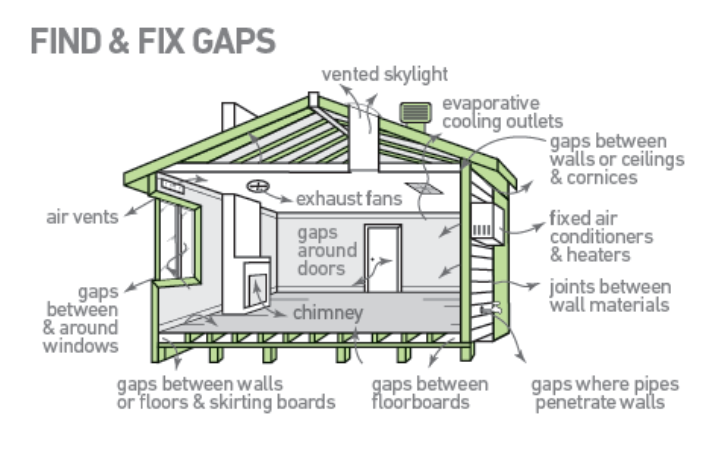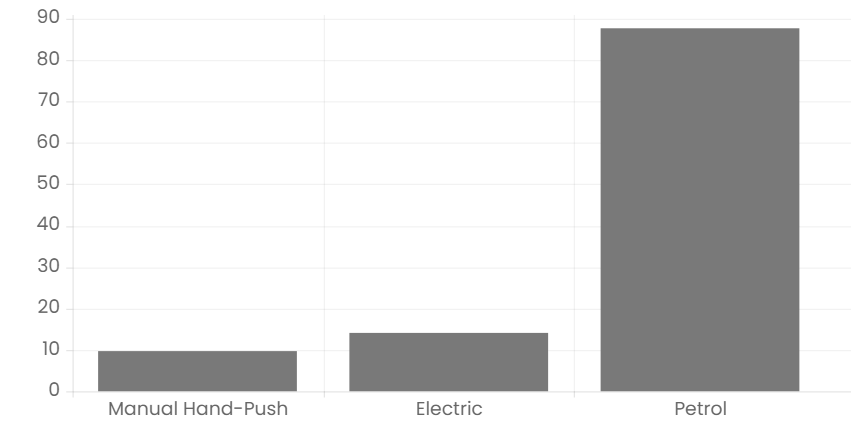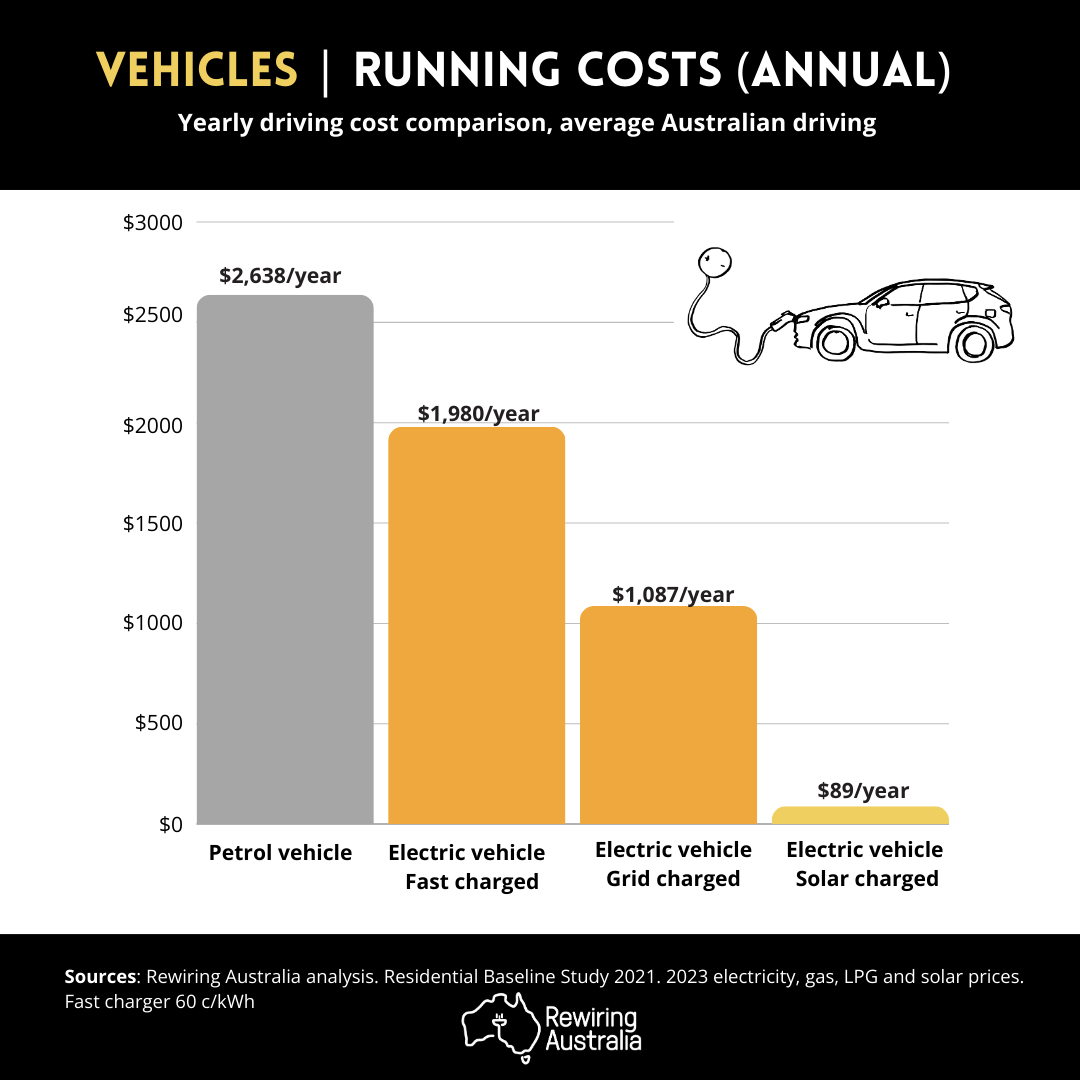Your Home Electrification Steps
Complete All -Electric Home
Once you’ve achieved the big 5 on your Home Electrification Guide, it’s time to chip away at the rest of your home to complete the transition to all-electric.

Start saving. Start by making your home more efficient
Going all electric is great, and making an efficient all-electric home is the gold standard. Things like draught proofing (sealing gaps), zoning unused areas of your home, and making sure you’ve got adequate insulation to keep heat inside your home.
And the good news is we’ve created an excellent resource you can use to learn and take action. Many of the items are DIY friendly, so there’s something to get stuck into right away.

Mower Carbon Emissions (kg CO2e) per year by type

Electrify your garden and cut down your emissions
The vast majority of garden devices used in Aussie yards are powered by fossil fuels, and their emissions are not regulated in the same way that car emissions are – with no catalytic converters or other devices to reduce the amount of harmful pollutants pumped into the air.
This is an often unconsidered consequence of our beloved backyards – CO2 emissions generated by power tools that is a significant source of pollution. The biggest polluters are:
- Leaf blowers
- Lawn mowers
- Edge trimmers
“The EPA estimates that fossil fuel lawn mower emissions account for as much as 5% of the US’s total air pollution”
You might not realise it, but garden equipment like lawn mowers emit nitrogen oxide and other volatile compounds that are 11 times more toxic than cars, and using the average petrol-powered lawn mower for an hour creates as many harmful pollutants as driving a typical car for 482km according to the US EPA!
While no data on lawn mower emissions exists here just yet, the US EPA estimates that fossil fuel lawn mower emissions account for as much as 5% of the US’s total air pollution.
If you think lawn mowers are bad, they’re nothing compared to leaf blowers – which may be the most polluting and least energy efficient device ever created.
Using a leaf blower blower for one hour is equivalent of driving 1,100 miles according to the California Air Resources Board. And during that time it will have emitted a vast amount of nitrogen oxide, carbon dioxide, fine particulate matter, as well as at least five known toxic carcinogens.
Not only does this create a vast amount of unnecessary harmful air pollution, but the use of fossil fuel-powered garden equipment perpetuates the destruction of the oil industry, with the US using 800 million gallons of fuel to mow lawns and cut hedges each year.
While much of this data comes from the US, it is still relevant in Australia and reflects our overall reliance on fossil fuel powered devices.

Unleash the power of a home battery
Installing a home battery with solar PV offers numerous benefits. It allows you to store excess solar energy generated during the day for use at night or during cloudy periods, reducing reliance on the grid. This not only lowers electricity bills but also provides a reliable backup during power outages. A home battery system optimizes the efficiency of solar panels, enabling homeowners to maximize self-consumption and reduce carbon emissions. Additionally, it contributes to energy independence, lessening vulnerability to fluctuating energy prices, and supports a more sustainable future by using clean, renewable energy to power your home.

Electric vehicle: The last step
The largest contributor to carbon emissions and energy costs for most households is their petrol or diesel car. Unfortunately, it’s also the single most expensive fossil fuel powered appliance to electrify. But if you’re not towing a caravan or needing huge towing capacity, the numbers stack up favourably.
On average, households spend over $3,000 annually on fuel. In contrast, driving an electric vehicle (EV) costs just 1-2 cents per kilometre using energy from rooftop solar, and 4-6 cents per kilometre using grid electricity. This is significantly cheaper than the 20 cents per kilometre it costs to drive a typical petrol or diesel vehicle at $2 per litre. Additionally, internal combustion engine vehicles emit thousands of tonnes of carbon, making EVs a more eco-friendly and cost-effective alternative.
Fix it when it fails, replace it when it ends.
Are You Eligible for Financial Assistance?
Going all-electric can be tricky. Create your free, personalised electrification guide to help!
Get your personalized Home Electrification Guide to help prioritise your upgrades, maximize your savings, and get started on your electrification journey!

Next step FAQ's
Where can I get electric garden equipment in Wangaratta?
There’s a good selection at Wangaratta Saw & Lawn Mower. Bunnings also have a decent range.
Are there any incentives for purchasing an EV?
The federal government is offering incentives for EV uptake in the form of fringe benefits tax. But this is a fast-paced industry so it’s likely there will be more incentives coming soon. Check out the page by the Electric Vehicle Council.
Explore the electrification projects
Start your all-electric home journey today
The Home Electrification Guide is a tool we’ve created to help Wangaratta homeowners navigate their transition to an electrified future. It’s free and takes 2 min to complete.
